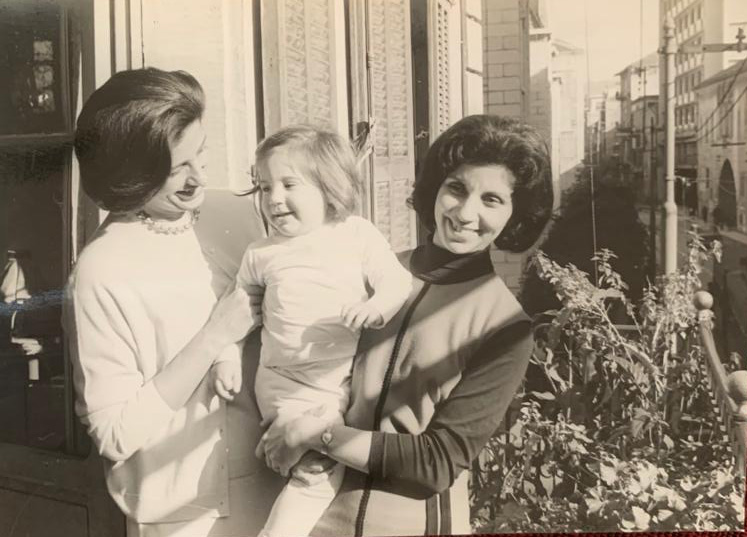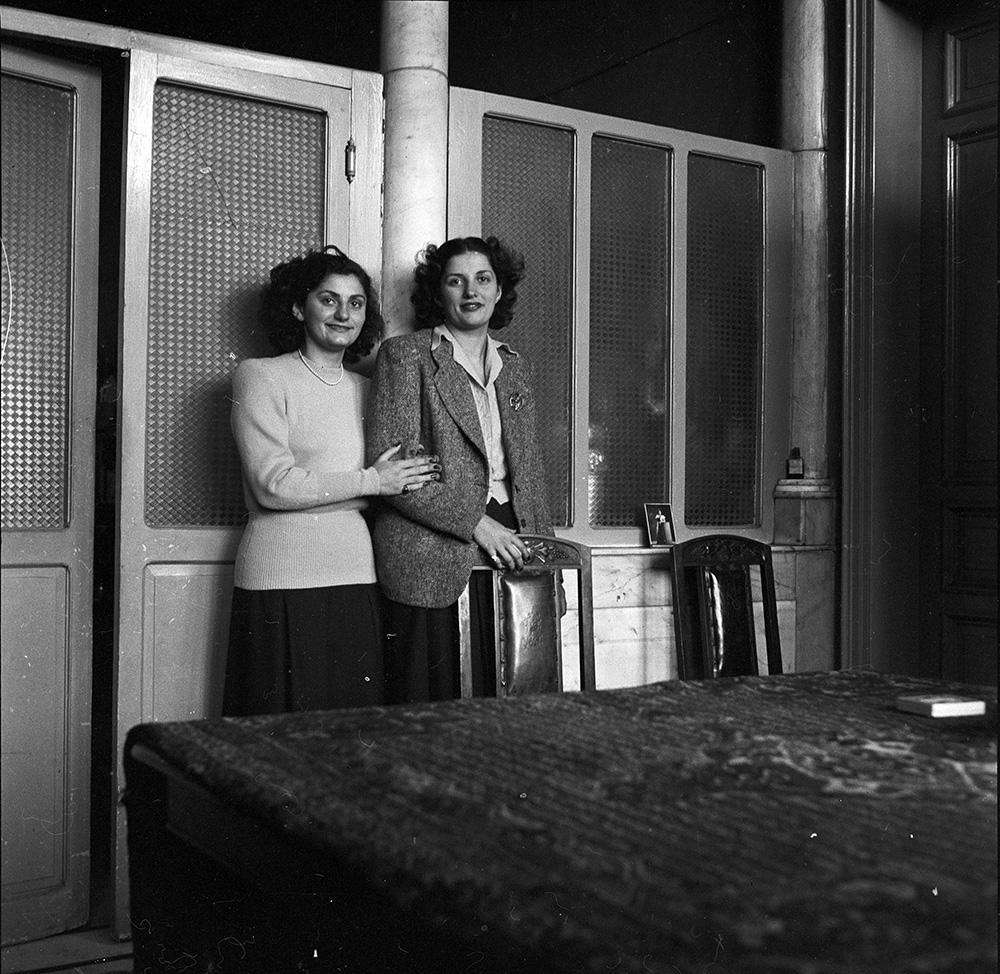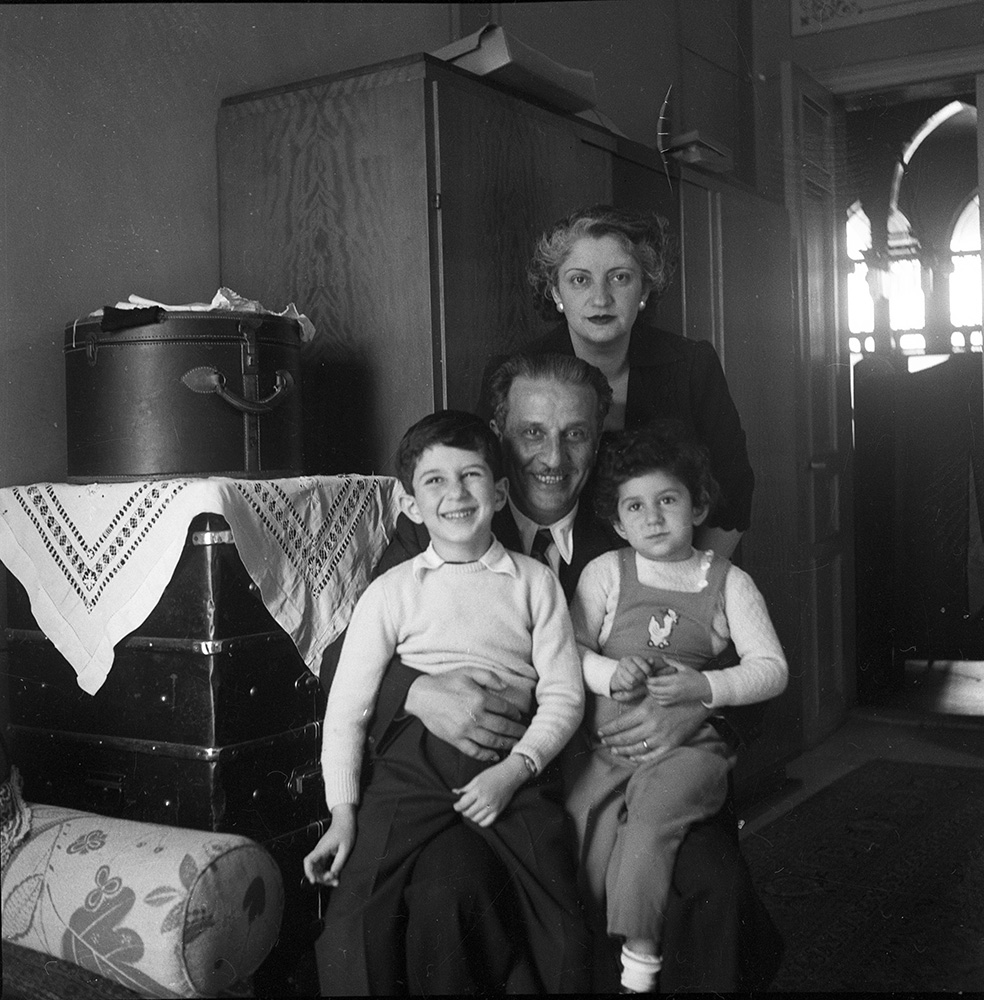
The author, Zina Hemady, with her mother Nuha Baddoura Hemady and Aunt Nadia Baddoura Kawar on the balcony of her grandparents’ Gemmayzeh apartment, overlooking Rue Goureaud, 1964. Phot. Baddoura Family Collection
By Zina Hemady
Beirut’s historical district of Gemmayzeh came under the international spotlight when it took the brunt of the blast that pulverized the city’s ancient seaport and ripped through nearby residential areas killing and maiming dozens of people and causing unimaginable damage. The neighborhood’s charming early 20th century buildings, that had survived the civil war and ensuing gentrification, partially or totally collapsed under the impact of the explosion which ranks among one of the worst of its kind in history.
Besides the tragic human toll of this Beirutshima, a blast blamed on the detonation of 2,750 tons of ammonium nitrate, the explosion was yet another blow the country’s cultural heritage. To the generation that came of age in post-civil war Lebanon, Gemmayzeh became synonymous with hip restaurants and bars nestled among architectural gems which miraculously survived the pitched battles that raged only a few dozen meters away, in downtown Beirut, during the early stages of the 1975-1990 civil war. As the area took on a bohemian flair, art galleries, and design studios gravitated to Gemmayzeh adding to its appeal as one of Beirut’s number one attractions.

An early 20th century postcard of Rue Goureaud showing the tram and the typical architecture that characterized Gemmayzeh. Phot. Norbert Schiller Collection
To me, Gemmayzeh was my mother’s childhood home. The Baddoura sisters, as they were known among their generation of Beirutis who grew up under the French mandate and during the early independence era, were raised in an apartment on Gouraud Street, named after the French general Henri Gouraud who founded Greater Lebanon in 1920. Their home was located just east of what is now the trendy French Paul bakery and next door to the Catholic College Sacre Coeur Freres, Gemmayzeh. Back then, Gemmayzeh was a sedate middle-class residential district of Beirut connected by tramline to the more vibrant sectors of the city such as Sehet el Bourj in the city center, to Bliss Street, home to the American University of Beirut, and beyond. The tram, which became extinct in 1968, passed right under my grandparents’ house providing a lifeline to my mother and her sisters who rode it everyday while attending the American Junior College for Women, and subsequently while two of them went on to AUB.

Leila Baddoura Saad and her older sister Nadia in their parents’ dining room, late 1940s. Phot. Baddoura Family Collection
As a young girl, I remember family gatherings at the home of my maternal grandparents, Farid and Laure Baddoura. Their Ottoman-era building had no elevator and we had to climb up two steep flights of stairs to their apartment, which struck me as relic from another era. In contrast with our shiny, modern 1960s flat near AUB, which was a prime sample of Beirut’s golden era, my grandparents’ home seemed dark and grey, an eerie place with high ceilings and heavy, ornate furniture. But once past the front door, my apprehensions subsided as I sensed my mother’s affection towards her childhood home. While Nuha and her sisters fell back into the family cocoon, my cousins and I bonded over childhood games discovering the nooks and crannies of our grandparents’ “mansion” which also included Farid’s dentistry clinic. At lunchtime, we all squeezed around the dining room table to savor my grandmother’s home-made cooking, namely her famous shish barak, dumplings floating in yoghurt sauce and topped with dried mint, and kibbeh meshwiyeh, large balls of minced meat mixed with crushed wheat and stuffed either with ghee or goat labneh and then grilled to perfection.

Suheil and Nayla Kawar with their maternal grandparents Farid and Laure Baddoura. They lived in the Gemmayzeh house for 8 years when their family was exiled from Palestine after 1948. Phot. Baddoura Family Collection
As I matured, way before my time like most of my Lebanese peers who grew up during the civil war, I came to realize that my grandparents’ house was also a place of refuge and tolerance. When my aunt Nadia, whom we always treated like the eldest although she had a twin sister– Samira, married at age 18 she moved to Jerusalem with her dashing husband Kamal Kawar. A few years later, after the Palestinian Nakbah of 1948, the young family, which by then also included my 3-year-old cousin Suheil and his infant sister Nayla, came back to my grandparents’ house in Gemmayzeh to regroup and start from scratch. My mother, who by then was studying pharmacy at AUB, gave up her room and moved into what was considered a storage space to provide her sister and her family with the comfort they needed. To this day, my cousin Nayla, who was practically born in that house, remembers the familial love and warmth that soothed the pain of loss and exile.

Nuha Baddoura Hemady sits between her father Farid and her mother Laure at their house in Gemmayzeh on the day of her wedding, 1958. Phot. Baddoura Family Collection
It was also in this house where my parents became husband and wife. In fact, to achieve this union, Nuha and Kamal had to jump through hoops and hurdles as they came from different religious backgrounds. My father was a Druze and my mother a Greek Catholic. Since it is forbidden for a Druze to marry an outsider, and in the absence of civil marriage in Lebanon, my parents solved their problem by having two weddings. One was consecrated by a Moslem sheikh, as my father was Moslem on his mother’s side, and the other by a pastor, as my grandmother Laure was a Protestant. The second ceremony took place at the Gemmayzeh house and spoke volumes of my grandparents’ tolerance and open mindedness in a country where sectarian divides could have lethal consequences. The fact that the wedding took place in 1958, the year that Lebanon had a civil strife that served as a warning to the worst yet to come, is a further testament to the spirit that reigned in that house.
When the civil war broke out in 1975, Beirut was split into a western and eastern sector with a large swath of destruction separating the two parts of the city. Gemmayzeh fell on the eastern side of the Green Line, not too far from my grandfather’s house. By then, we had started referring to the place as Jiddo’s house as my grandmother had passed away suddenly in 1973 while she rested in her bed after experiencing a malaise. The neighborhood fell under the control of the hardline Christian Phalange Party which considered Palestinians and their leftist allies the archenemy. In addition to my grandmother’s absence, from which her husband never recovered, the war extinguished the lights on the Gemmayzeh house. It was no longer safe for my father and my uncle, both named Kamal, to visit that part of the city as they were now considered persona non grata. My aunt Samira and her family, who lived in nearby Ashrafiyeh, had the easiest access to the family home while my mother and her two other sisters, Nadia and Leila, waited for respites from the fighting to visit their father.

Samira Baddoura Baz stands on the balcony of her parents’ home at Gemmayzeh. Phot. Baddoura Family Collection
Long after my grandfather had joined his beloved wife in 1982, the Gemmayzeh house took its final breath. At the end of the Lebanese conflict in 1990, the downtown area was being cleared from mines to remove wartime barriers and reunify Beirut. Unfortunately, the old house no longer had the energy to withstand yet another shock to its foundations and crumbled under the effect of a peace time explosion. It has now been reduced to an empty lot, covered with overgrowth and surrounded with a chain-link fence. All that remains from our memories of the maternal house is the bronze plaque that carried my grandfather’s name and advertised his practice. This cherished memorabilia is now in the safe hands of my cousin Carla who salvaged it from the ruins.

The home of Farid and Laure Baddoura on the corner of Goureaud and Youssef Hani streets in Gemmayzeh is now an empty lot covered with overgrowth. Phot. Norbert Schiller
After the August 4th 2020 blast, which caused nearly as much damage to Beirut within the span of 15 minutes as did 15 years of civil war, Gemmayzeh became a symbol of resistance against the annihilation of Beirut’s heritage. As residents picked up their dead and healed their wounded, they vowed to hold on to their neighborhoood in the face of real estate vultures seeking to take advantage of this tragedy. Decades ago, enlightened families with deep roots in Gemmayzeh, like my own, resisted the tide of fanaticism and sectarianism embracing openness and tolerance which could have saved Lebanon from its terrible predicament. Today, we need more Lebanese to adopt the spirit that reigned in my grandparents’ house to reincarnate Beirut into the best version of itself.

Zina this is so moving, so well written, so poignant and your mother and father were amazing. Wish I had the chance to know them. Come back soon. We miss you here in Beirut.
Beautifully written piece Zina, exactly the kind of literature I enjoy reading combining history with family stories and old photos! Love it, takes me back to novels about old Beirut, Alexandria, Haifa, Jerusalem or any city in our torn levant 🙁 xxxxxxx
Love it!
Nadia Kawar was the best friend of my godmother, Renee Makdissi, née Gorkiewitz, from a Levantine European family with roots in Poland and England, as well as France. I’m happy that they have been spared the experience of Beirut’s latest devastation. I often crossed paths with Nadia at Renee’s home on Rue Jeanne d’Arc.
A beautiful piece— thank you, Zina Hamady.
Beautiful piece Zina
You managed to strike a balance between documentary and personal chronicle.
Written with a lot of emotion without being sentimental.
A joy to read.. And the photos are precious!
Dear Zina,
This piece was shared on Facebook numerous times so that I read it shortly after it was published. I found it wonderful and tragic at once – and wished for more! So I found myself drawn back to it.. Thank you for sharing your memories.
I’d like to ask you a question regarding Kamal Kawar-was he a film producer who worked amongst others with Henri Barakat on Al Hob al Kabir? If so, I’d love to hear more about him…
warm regards,
Nathalie
Hello dear Zina, I enjoyed reading your article about the Gemayzi area and its inhabitants in the old times. I loved it more when I realized that I know those you mentioned, most of them in names, but in person I know well the late Samira Baddoura Baz, who is the mother of my dear and loving boss : Dr Freddie Baz. I worked with him 25 years at Bank Audi. I love all his family and it’s a reciprocal feeling. I am so happy to meet you on Facebook. Happy Easter and hope to meet in person soon. Take care and stay safe 🙏❤️
Zina, what a beautiful and heartbreaking piece. I have lived in your grandparents’ neighbourhood for the past 5 years. The love I feel for this place is just a small fraction of what people like you who have roots here must feel for it, and I love it quite a bit myself. This piece captures so well the indescribable beauty and the loss of something that, as you say, I hope with my whole heart will one day return to dwell here. I have read it over and over and bookmarked it so I can read it again. I hope you find your way back here, at least occasionally. Take care 🙂
I remember very well uncle Farid and ” tante Laure” and olso the house in Gemayze and olso in front the house of uncle George and in ” place Debbas” uncle Najib and his wife ” tante Elise”.
I pass with all a very very good time.
Prof.Said J. Bitar architecte urbaniste.
Son of Margot Baddoura Bitar